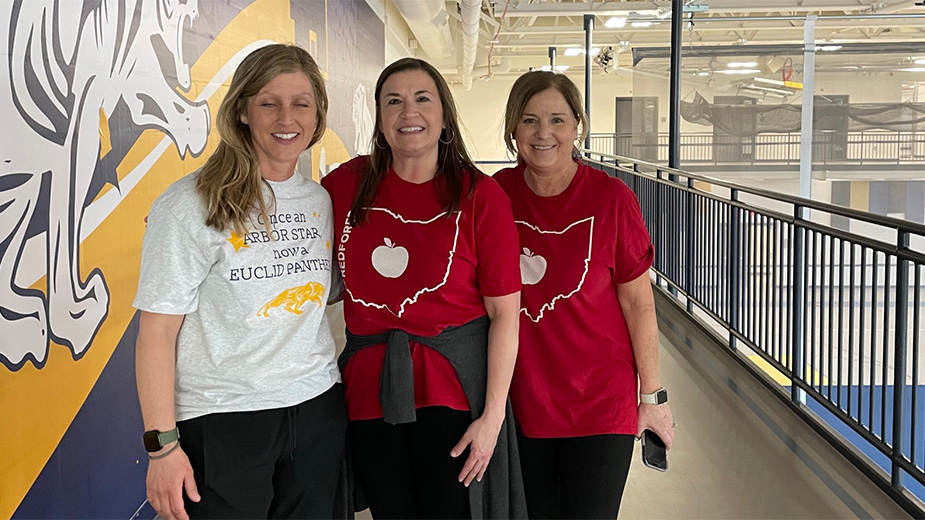Ohio Schools Experiment with Sensory Rooms
By Nathalia Teixeira
Kent State News Lab
The Student Tranquility Amygdala Reset room (Star room), is a place to self-regulate at Euclid Middle School in Euclid and Kinder Elementary School in Miamisburg.
The students check in, and the Student Assistance Program, which connects students with resources to remove obstacles to learning, records where they are. Using a pulsometer, the students check their heart rate and identify their own zone of regulation. The students choose two or three activities to calm themselves.
The Star room, like many sensory rooms, has a little bubble lamp, a beanbag chair and a VR headset with a calming app.
Kids can review their biometrics and see the connection between a body and mind in anxiety and one that is not.
Debora Robison, director of outreach and collaboration for the Ohio School Wellness Initiative, described a student who was having trouble with his self-regulation going to the office for several days in a row. He started going to the Star room daily to use the VR headset after lunch, which was when he struggled most. He went from going to the office often to not being in the office at all.
“This is a success story of how you integrate mental health into a school in a way that’s not a therapist and not a psychiatrist,” Robison said. “We’re teaching kids how to regulate their bodies so they can take care of themselves.”
The Ohio School Wellness Initiative was implemented during the COVID-19 pandemic in response to disruptions to schooling. Since the initiative’s start, the principal of Kinder Elementary School, Rebecca Huber, said the school has seen a 58.9% reduction in office referrals and a 57% reduction in major incidents.
They also had a 48.5% reduction in suspensions, a 46% reduction in fights and a 43% reduction in classroom-based referrals, Huber said.
“It’s helping people focus on the whole child and the whole community. Instead of just teaching kids to read, it’s teaching them how to be citizens,” Huber said.
The initiative started because of a grant through Gov. Mike DeWine’s emergency education relief fund. The Ohio Department of Mental Health and Addiction Services, Ohio Department of Education and Miami University sponsored the initiative. The OSWI staff developed all the materials, did coaching and technical assistance and piloted the program with 80 schools.
“We’ve tweaked our system to be more of a problem-solving community,” Huber said.
Beyond the Star Room
One of the Ohio School Wellness Initiative’s goals is to give power to anyone willing and interested in helping someone struggling with their mental health.
“If we can help people be confident as a citizen, not everybody has to be a mental health therapist to help somebody with mental health,” Robison said.
Robison said other programs include Youth Mental Health First Aid training and a website containing information about mental health for young people.
“It’s like a one-stop shop for parents, teachers and, really, anybody in the community,” Robison said.
They are also working with a company called CampusWell, which creates short videos made by young people about mental health and well-being, which they push out on YouTube and advertise to other teens and young adults.
Sylvia Green, a behavioral health and wellness specialist at Euclid Middle School, brought yoga and dance therapy to her summer classes, which she hopes to continue throughout the year.
“It gives [students] an opportunity to, in the space, to talk about their problems, what’s going on with them,” Green said. “It also gives them social-emotional learning and how to deal with your stress.”
Helping Kids Recover from COVID-19’s Mental Health Effects
Green said that after the pandemic, anxiety and depression went up among Ohio’s children, and there’s still more need to pay attention to mental health in schools.
“Our kids have been through so much lately, and we live in a society that is so dysregulated that even when we think students are sitting and paying attention, they’re dealing with a whole lot of other things,” Huber said. “So we need to teach them through these activities how to self-regulate so they can actually open themselves up and be ready to learn.”
Kinder Elementary School implemented a new social-emotional learning curriculum that uses purposeful people and focuses on the power of being kind, strong and well.
“All of these things are interrelated,” Robison said. “When we have schools that really prioritize mental health and well-being and not just for students but for staff as well, then they’re starting to see some real differences in the way their students come prepared to learn and are able to learn.”
Nathalia Teixeira wrote this article for Kent State News Lab. This collaboration is produced in association with Media in the Public Interest and funded in part by the George Gund Foundation
Pictured at top: Photo by Rosalie Murphy. (Kent State News Lab)
Published by The Business Journal, Youngstown, Ohio.



